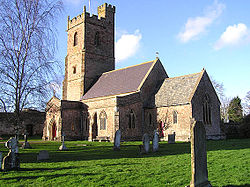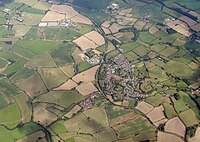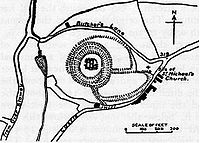Nether Stowey
| Nether Stowey | |
| Somerset | |
|---|---|
 Church of St Mary the Virgin, Nether Stowey | |
| Location | |
| Grid reference: | ST194398 |
| Location: | 51°9’7"N, 3°9’14"W |
| Data | |
| Population: | 1,482 (2021) |
| Post town: | Bridgwater |
| Postcode: | TA5 |
| Dialling code: | 01278 |
| Local Government | |
| Council: | Somerset |
| Parliamentary constituency: |
Bridgwater |
Nether Stowey is a large village in Somerset, in the foothills of the Quantock Hills. It sits just below Over Stowey. Its parish covers had a population of 1,482 at the 2021 census, and is part of the Williton and Freemanners Hundred.[1]

History
The Iron Age fort of Dowsborough lies about one and a half miles west of the village.
In the Domesday Book of 1086 it was recorded as Stawei, the name coming from the Old English stan weg, or paved road.
Nether Stowey may have been a borough as early as 1157 or 1158, but by 1225 it is officially recorded as such. The economy of the mediæval town was based on textiles and pottery, and it had both a weekly market and a yearly fair after 1304.
During the "Bloody Assizes" in the autumn of 1685, in the aftermath of Duke of Monmouth's Rebellion, men from Nether Stowey who were caught up in the rebellion are said to have been hanged, drawn and quartered in the village after they were sentenced to death by Judge Jeffries. Their body parts were then displayed around the village to discourage others from rebellion against King James II. Many villages throughout the West Country were witness to the same bloody retribution.
About the village
Castle

Stowey Castle is a Norman motte-and-bailey castle, built in the 11th century. The blue lias rubble walling is the only visible structural remains of the castle which stand on a conical earthwork with a ditch approximately 820 feet in circumference.[2] The castle was destroyed in the 15th century, which may have been as a penalty for the local Lord Audley's involvement in the Second Cornish Uprising of 1497 led by Perkin Warbeck.[3]
The castle is a scheduled monument[4] and the foundations of the keep are a Grade I listed building.[2]
Church
The Church of St Mary the Virgin has a 15th-century tower, with the remainder of the church being rebuilt in 1851 by Richard Carver and Charles Edmund Giles. It is a Grade II* listed building.[5]
Stowey Court
Stowey Court may contain part of Lord Audley's original house which was left unfinished after his execution in 1497 until his descendants rebuilt the half-finished dwelling.[6] Most of the current building is 19th and 20th-century.[7] In 2008 the British Museum exhibited a hoard of silverware that was found near Stowey Court. The spoons, a goblet and a bell shaped salt cellars are thought to date from the time of the Civil War and they were recently discovered in a broken earthenware jar using a metal detector.[8]
Stowey Court is a Grade II listed building.[9]
Coleridge Cottage
Coleridge Cottage was, between 1797 and 1799, the home of Samuel Taylor Coleridge, one of the founders of the Romantic Movement in poetry (along with William Wordsworth, who himself lived three miles away). It was here he wrote the poems The Rime of the Ancient Mariner and Kubla Khan.
The cottage is a Grade II* listed building.[10]
The Coleridge Way starts at the cottage and celebrates his walks in the area.[11]
Poole House
Poole House is thought to have been built in the late 17th century although some parts may be even older. Local tanner, politician and philanthropist Thomas Poole lived in the house in the late 18th and early 19th century. Poole provided a cottage, Coleridge Cottage, for the use of the romantic poet Samuel Taylor Coleridge. Coleridge spent much time in Poole House, reading and writing in the barrel room. William Wordsworth and his sister were also frequent visitors.
Poole House is now a grade II listed building[12] and many original features remain including fireplaces and the Georgian interior.[13]
Clock Tower
The Clock Tower in St Mary Street was built in 1897. During 2011, the Clock Tower underwent a major refurbishment job which saw the replacement of several components of the bell chiming system. The tower also received a fresh coat of paint.[14]
The Clock Tower is a Grade II* listed building.[15]
Outside links
| ("Wikimedia Commons" has material about Nether Stowey) |
References
- ↑ "Somerset Hundreds". GENUKI. http://www.genuki.org.uk/big/eng/SOM/Miscellaneous/.
- ↑ 2.0 2.1 National Heritage List 1059074: Remains of Keep to Stowey Castle (Grade I listing)
- ↑ "Nether Stowey". Quantock Online. http://www.quantockonline.co.uk/quantocks/villages/netherstowey/netherstowey1.html.
- ↑ National Heritage List 1019421: Stowey Castle, the site of St Michael's Chapel and a mediæval kiln site, Nether Stowey (Scheduled ancient monument entry)
- ↑ National Heritage List 1344922: Church of St Mary the Virgin (Grade I listing)
- ↑ Waite, Vincent (1964). Portrait of the Quantocks. London: Robert Hale. ISBN 0-7091-1158-4.
- ↑ National Heritage List 1059041: Stowey Court (Grade @ listing)
- ↑ British Museum to Manage Portable Antiquities Scheme, as Exciting New Finds Go on Display Template:Webarchive, Art Daily, accessed 8 December 2010
- ↑ National Heritage List 1059041: Stowey Court, Nether Stowey (Grade II listing)
- ↑ National Heritage List 1344921: Coleridge's Cottage, Nether Stowey
- ↑ "Coleridge Cottage". Somerset Guide. http://www.somersetguide.co.uk/photos/img225.htm.
- ↑ National Heritage List 1237293: Poole House (Grade II listing)
- ↑ "Poole House". Poole House. http://www.poolehouse-quantocks.co.uk.
- ↑ "Clock Tower". Somerset Guide. http://www.somersetguide.co.uk/photos/img224.htm.
- ↑ National Heritage List 1344925: Clock Tower, Nether Stowey (Grade II* listing)
